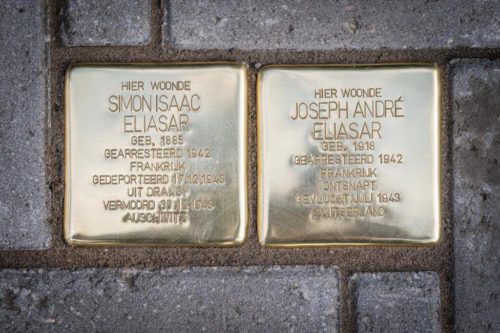Searching for the Dutch-Paris Escape Line
Stumbling Stones and Dutch-Paris
Let’s continue our discussion of how private citizens have influenced the public memory of the Second World War. We began with Memorial naming the victims of the Soviet regime in the USSR. Last time we mentioned how an association in France added the name of a Dutch-Paris resister to the war monument in his home town in 2023, 78 years after his death in a concentration camp.
Dutch-Paris has also been remembered in at least two “Stolpersteine” or “stumbling stones.” These are 10cm square brass plaques placed in the cobblestone pavement outside of the last known, freely chosen residence of a victim of the Nazis before they were killed or escaped persecution through emigration or suicide. Of course many honor Jews, but the stumbling stones honor all victims of the Nazis including resisters who were killed in custody. Each one is handmade and reads: “here lived” followed by the victim’s name, date of birth and what happened to him or her.
The two Dutch-Paris stumbling stones that I know of honor a Jewish father and son who escaped from the Netherlands with help from Dutch-Paris. The father’s includes the year he was arrested in France, the date he was deported from Drancy and the date he was vermoord (murdered) in Auschwitz. The son’s says “gearresteerd 1942 Frankrijk ontsnapt gevlucht Juli 1943 Zwitserland” (“arrested 1942 France escaped fled July 1943 Switzerland).

The stumbling stones began as the private project of an artist in Berlin in 1992. The stumbling stones are a grass-roots initiative in that the families of victims, the inhabitants of a building and school groups initiate each stone. But the artist still personally approves each stone and oversees its creation. Approval requires a fair bit of paperwork and, possibly, negotiation over the wording. Also, the owner of the building must agree and family members must be contacted. They are installed with due ceremony. A stumbling stone is not just something you order online as a last minute gift.
Such stumbling stones can now be found in dozens of cities, making them the largest decentralized monument in the world. They represent the intersection of private memory and public memory and prove that although the Second World War ended almost 80 years ago, it is far from over in our collective memory or culture..


Leave a reply